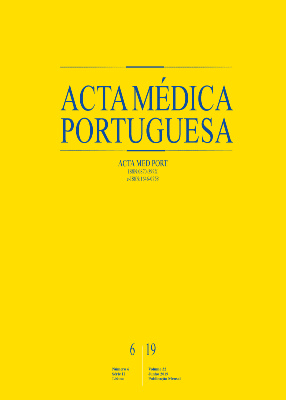Sociodemographic Determinants of Caesarean Delivery in the Largest Public Maternity Hospital in Angola
DOI:
https://doi.org/10.20344/amp.10409Keywords:
Angola, Cesarean Section, Socioeconomic FactorsAbstract
Introduction: This study aimed to describe demographic, socioeconomic and pregnancy-related characteristics associated with a caesarean delivery in Luanda.
Material and Methods: We conducted a cross-sectional study which included 995 puerperal women and who were assessed between December 2012 and February 2013 at Lucrécia Paím maternity hospital in Luanda, Angola. Data was collected using a structured questionnaire administered by trained interviewers. Logistic regression models were fitted to estimate the magnitude of associations (odds ratios—95% confidence intervals) between the type of delivery and variables showing a significant association in the bivariate analysis.
Results: The prevalence of caesarean section was 44%. Women with caesarean delivery were less educated, resided more often in a periurban area and were more likely to disclose lower family income when compared with women who had vaginal delivery. Living in a periurban area was significantly associated with a caesarean delivery regardless of all covariates considered, for primiparous women (adjusted odds ratios, 95% confidence intervals = 2.14, 1.27 – 3.62) and for multiparous women (1.78, 1.26 – 2.51). Among multiparous women, a lower family income was also significantly associated with caesarean delivery. Hypertensive disorders during the current pregnancy were associated with a caesarean delivery in the multivariate models fitted for primiparous (3.96, 1.57 – 9.98) and for multiparous women (1.68, 1.03 – 2.74).
Discussion: The associations between low socioeconomic position and high risk of caesarean delivery demonstrated in this study are consistent results in previous researches curried out in African contexts. The poorer and less educated women, who live far from health facilities, have few antenatal care visits and often arrive with complicated conditions, justifying a caesarean delivery. Lack of qualified human and material resources to manage emergencies in peripheral health centers and delaying in the reference system also leads to an increase in the number of caesareans performed in this particular maternity hospital.
Conclusion: Sociodemographic differences were observed according to the type of delivery. Cesarean section was more prevalent among women with lower income and residents in periurban areas.
Downloads
Downloads
Published
How to Cite
Issue
Section
License
All the articles published in the AMP are open access and comply with the requirements of funding agencies or academic institutions. The AMP is governed by the terms of the Creative Commons ‘Attribution – Non-Commercial Use - (CC-BY-NC)’ license, regarding the use by third parties.
It is the author’s responsibility to obtain approval for the reproduction of figures, tables, etc. from other publications.
Upon acceptance of an article for publication, the authors will be asked to complete the ICMJE “Copyright Liability and Copyright Sharing Statement “(http://www.actamedicaportuguesa.com/info/AMP-NormasPublicacao.pdf) and the “Declaration of Potential Conflicts of Interest” (http:// www.icmje.org/conflicts-of-interest). An e-mail will be sent to the corresponding author to acknowledge receipt of the manuscript.
After publication, the authors are authorised to make their articles available in repositories of their institutions of origin, as long as they always mention where they were published and according to the Creative Commons license.









